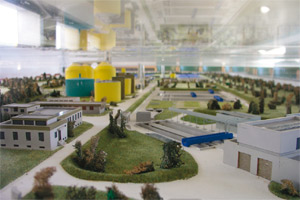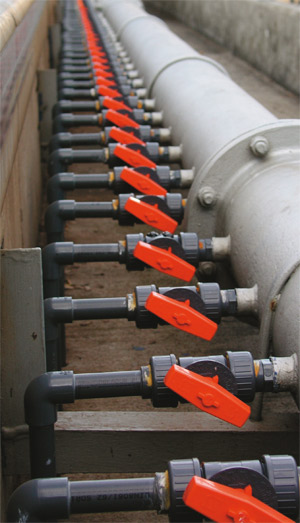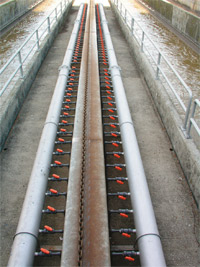320 ProfiDos dosing ball valves blow compressed air into the grit channel in the Augsburg wastewater treatment plant
An array of valves causes quite a stir
The task of a grit channel in a wastewater treatment plant is to separate the grit in the inlet from the wastewater, and at the same time remove the floating constituents such as grease in an initial stage.
The purely mechanical process is assisted by blowing compressed air into the basin. Last year, the system for blowing compressed air into the grit and grease channel in the wastewater treatment plant in Augsburg was completely renewed. The previously installed throttle valves, which were imprecise, were replaced by 320 precisely adjustable dosing ball valves from ASV Stübbe – one every 25 centimetres.
A grit washing plant had already been installed in the local authority-owned water treatment plant in 2002. A 40 metre long, two-line grit and grease channel is installed upstream of the plant. The wastewater is set in motion in the channel by compressed air, which creates a vortex at a depth of half a metre. This rotation stirs up the mass of water and waste, and separates them. The heavy particles sink and settle at the bottom of the basin. Grease and oil combine to form lumps as big as tennis balls and float to the calm areas at the side of the basin, where they are skimmed off. A constant supply of compressed air is essential for ensuring the optimum separation of the mineral particles from the organic particles.
“Some of the old throttle valves were no longer fully functioning. Attempts to adjust the flow by changing the ball position caused the spindles to crack. Therefore complete renewal was necessary,” explains Renato Storch, ICA engineer. The size of the valves was determined by the existing plant dimensions. The local authorities are forced to economise and Renato Storch found an affordable solution from ASV Stübbe. The modernisation was realised in cooperation with Dirk Frings of K-Tec GmbH in Eichenau.
“The dosing ball valve ProfiDos 101 is easy to adjust, absolutely precise and relatively economical. There is nothing comparable on the market – as far as the value for money and performance is concerned,” says Renato Storch. One not insignificant additional argument in favour of the ASV valve was that no other manufacturer had any comparable valve in the required size. “The ProfiDos is unique,” says Renato Storch. The compressed air is supplied at a constant 0.5 bar.
The ProfiDos 101 is designed for chemical plants, and environmental and surface technology. It is available in four sizes from DN 15 to DN 50 in uPVC and polypropylene. A volume of up to 6,300 l/h can be supplied at a pressure of 1 bar. The ProfiDos valves installed in the Augsburg wastewater treatment plant are of the size DN 25. The core of this dosing ball valve is the circumferential dosing groove in the ball. The medium flows through the valve along this groove. The lever allows convenient, easy and reproducible setting of the ball position and indication of the opening position on a 180° scale.
The ProfiDos 101 is manufactured in one piece and can be radially mounted and removed. The union socket ends are available as per DIN 8063 for solvent (uPVC) and/or fusion welding (PP) in accordance with DIN/ISO. As an option, the valve can be connected to an external control system and fully automatically controlled via an electric actuator with positioner. A control loop, for example for controlling flow, pH value or conductivity, can be set up with the aid of a respective sensor.
The Augsburg wastewater treatment plant has been investing in new technology for decades and is one of the most modern wastewater treatment plants in Germany.
 Augsburg’s wastewater treatment has been and still is continuously optimized to prepare for the future and ensure that the wastewater charges do not spiral out of control. This approach has proven successful: The wastewater treatment plant in Augsburg serves as a shining example, and in nationwide comparison the wastewater charges in the Swabian metropolis are the lowest among all German cities.
Augsburg’s wastewater treatment has been and still is continuously optimized to prepare for the future and ensure that the wastewater charges do not spiral out of control. This approach has proven successful: The wastewater treatment plant in Augsburg serves as a shining example, and in nationwide comparison the wastewater charges in the Swabian metropolis are the lowest among all German cities.




Scrivi un commento